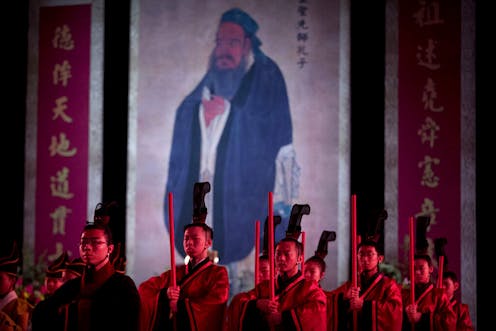There's a religious revival going on in China -- under the constant watch of the Communist Party
President Xi Jinping’s nationalist agenda includes supporting traditional Chinese religious beliefs and practices – as long as their leaders support the Chinese Communist Party.

The Chinese Communist Party is celebrating the 100th anniversary of its founding in 1921. For most of those decades, the party sought to restrict or obliterate traditional religious practices, which it considered part of China’s “feudal” past.
But since the late 1970s, the party has slowly permitted a multifaceted and far-reaching revival of religion in China to take place. More recently, current Chinese president and Communist Party leader Xi Jinping has endorsed continued party tolerance for religion as filling a moral void that has developed amid China’s fast-paced economic growth.
This support does come with caveats and restrictions, however, including the demand that religious leaders support the Communist Party.
As a scholar of Chinese religions, these considerable changes are of special interest to me.
A revival of religion
Atheism remains the official party ideology, with members banned from professing religious faith. The party’s aggressive efforts to obliterate all religious beliefs and practices reached a high point during the tumultuous decade of the Cultural Revolution, from 1966 to 1976. All temples and churches were shut down or destroyed. Any form of religious activity was prohibited, even as there was forceful promotion of the cult of Mao (Zedong), which assumed the role of an officially sanctioned religion.
As part of major reforms and a loosening of social controls, initiated in the late 1970s, the party has slowly accepted a range of behaviors and traditions that fulfill religious needs or provide spiritual outlets. Buddhism, Taoism, Catholicism, Islam and Protestantism – the five officially recognized religions – have staged comebacks, albeit with varying success.
There are increasing numbers of local temples, associations, pilgrimages and festivals, and growing numbers of Buddhist, Christian and Taoist clergy. Many religious sites are open for private worship and communal service and frequented by people from all walks of life.
Local governments are often keen to restore and promote religious establishments, largely to stimulate tourism and local economic development.
Consequently, a major metropolis such as Shanghai has become home to religious establishments large and small, official and underground. They range from local shrines to Buddhist and Taoist temples, churches and mosques. There are also new entrants to the religious scene, exemplified by the yoga centers that have sprung up in many Chinese cities.
It seems that people have welcomed these policy shifts. A 2020 study by the Pew Research Center found that 48.2% of China’s population had some form of religious affiliation.
The exact data is debatable, and it is difficult to conduct reliable research in China. But these results suggest that many Chinese participate in various activities that can be labeled religious.
A mix of religious practices
Traditionally, most Chinese people don’t subscribe to a single faith or construct a narrow religious identity. They engage with varied beliefs and practices, a pattern of religious piety dating back centuries to ancient imperial China.
That encompasses aspects of Buddhism, Confucianism and Taoism, as well as many practices termed “popular religion.” These range from visiting temples, attending pilgrimages and festivals, praying and offering incense, ancestor worship, and veneration of various celestial divinities. There are also the popular practices of geomancy or feng shui, an ancient art of harmonizing humans with their surroundings, and divination or fortunetelling.
These rich traditions often have regional variations, such as the veneration of Mazu, a sea goddess, which is especially prevalent in southeast China and Taiwan. Originally a patron goddess of seafarers, Mazu is widely worshiped by people from all walks of life and promoted as an important symbol of local culture.
Confucian rapprochement
The Communist Party has also stopped criticizing the teachings of Confucius, the famous philosopher and educator of the sixth and fifth centuries B.C. For much of the 20th century, Confucian teachings were rejected as discredited relics of an imperial past. But that changed over recent decades, as the party sought to reposition itself as the guardian of Chinese traditions.
This contributed to a significant revival of Confucianism.
Confucianism’s time-honored ethical framework offers guideposts to navigating the often-harsh realities of life in a highly competitive society. But the party has also found it useful to harness aspects of Confucianism that resonate with its core interests, such as obedience to authority and respect for the leader.
Accordingly, the government has supported reestablishment of Confucian temples and institutes. It has also sponsored conferences on Confucianism and even organized lectures on Confucian teachings for party officials.
Control and curation of religion
Adopting attitudes and methods with long-established precedents in the dynastic history of imperial China, the communist government positions itself as the ultimate arbiter of orthodoxy and heterodoxy, or proper and improper religious practices. Religious leaders must support the party and follow its directives.
Authorities keep firm administrative control over all forms of religious expressions and organizations, by whatever means they deem prudent or necessary. As we know from the reports of Western scholars and journalists, that control ranges from subtle forms of domination and co-option of religious groups to outright bans or repressions.
In 2015, the government removed 1,200 crosses from church buildings across Zhejiang province. In 2016, a Zhejiang court sentenced a Protestant pastor to 14 years in prison for resisting a government order to take down his church’s cross. In 2018, the government demolished the Golden Lampstand Church in Shanxi province.
In response, most religious groups tread carefully and engage in self-censorship, as I and others have observed during research trips in China.

China tends to treat religions perceived as potentially threatening to the established order harshly, especially if suspected of foreign ties or secessionist tendencies. For instance, for decades China has strictly regulated Buddhism in Tibet, as it has pursued policies aimed at suppressing the cultural and national identities of the Tibetans. That contrasts with more relaxed attitudes towards the form of Buddhism practiced by the Han majority.
The party has explained its recent, ruthless campaign to repress the Uighurs, a Muslim minority in Xinjiang – a nominally autonomous region in Northwest China – as intended to counteract terrorism and separatism. According to leaked documents, since 2014 up to a million Uighurs have been interned in “re-education camps.” It’s part of a hardline policy of secularization and “Sinicization,” which implies assimilating the Uighurs into the majority Han culture, at a loss of their religious and ethnic identities.
Balancing act
As it celebrates its 100th anniversary, the Chinese Communist Party seeks to project the image of a unified nation returning to global political and economic dominance.
But at home it faces manifold problems and is engaged in a balancing act: affirming its dual role as a guardian and curator of traditional Chinese culture and religion, but in a manner that enhances rather than undermines its power and authority.
[Explore the intersection of faith, politics, arts and culture. Sign up for This Week in Religion.]
Mario Poceski does not work for, consult, own shares in or receive funding from any company or organization that would benefit from this article, and has disclosed no relevant affiliations beyond their academic appointment.
Read These Next
From truce in the trenches to cocktails at the consulate: How Christmas diplomacy seeks to exploit s
World leaders like to talk up peace at Christmastime. But alongside the tales of seasonal breaks in…
The world risks forgetting one of humanity’s greatest triumphs as polio nears global eradication − 7
Polio may finally be defeated in the next 5 years. Will the world recognize what an extraordinary achievement…
People are getting their news from AI – and it’s altering their views
Even when information is factually accurate, how it’s presented can introduce subtle biases. As large…





